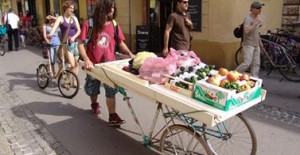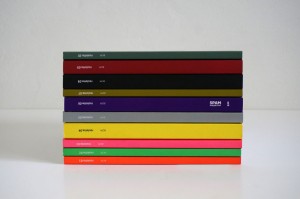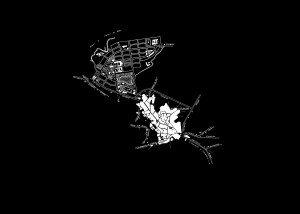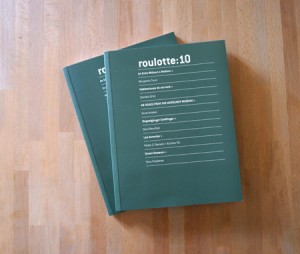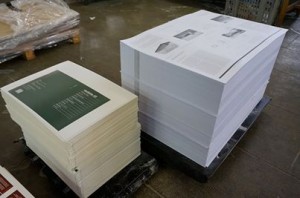text from Existenzminimum, Fundació Espais d’Art Contemporani, Girona 2002
La position d’un agent dans l’espace social s’exprime dans le lieu de l’espace physique où il est situé (celui dont on dit qu’il est “sans feu ni lieu” ou “sans domicile fixe” n’a –quasiment– pas d’existence social) […]
Pierre Bourdieu, La misère du monde.
Presentation 1
Someone is walking aimlessly in the middle of a leafy wood. We cannot see him, we can only detect his passage by the movements of the branches and the sound of his footsteps. The rustling of the vegetation as it is torn and broken by the weight of the invisible walker can be heard faintly, but it is so incessant that it produces a feeling of anguish. The persistent action of the passer-by places us in an unnerving situation. As we gradually become aware that in the images we cannot identify anyone in particular, our insecurity increases to such an extent that the impossibility of distinguishing any sign of individuality creates a great uneasiness. In fact, the contemplation of the walk through the wood is not pleasant for us because, on the one hand, we are faced with something which implies a loss and, on the other, because it alludes to a displacement undertaken without the suitable provisions. Nowhere is there anything to suggest to us that the passer-by will find a clearing in the thicket which will make his situation more bearable. On the contrary, the behaviour of this enforced nomad –who acts as a kind of mediating self, and therefore extends its needs to others (us)–, which refers us to a setting of helplessness and exclusion, becomes a revealing symptom of the ideological and cultural crisis which the modern narratives with a desire for emancipation are undergoing at the present time. Habitar sense deixar rastre (Inhabiting without leaving traces) is a videographic work by Domènec to which these brief impressions belong. Filled with an ambiguous lyricism, it announces the construction of a powerful parabola of our contemporaneity, more determined than ever by the dangers of globalization, or to be more exact, by those of capitalist universalization1.
Friedrichsfelde Cemetery of Berlin: a history of the twentieth century
At the beginning of February, 1919, the political programme of the Spartacus Group was published in the pages of the Spanish newspaper El socialista2. It consisted of a posthumous homage –almost in real time– to Rosa Luxemburg and Karl Liebknecht, principal leaders of the proletarian revolution in Germany during the winter of 1918-1919, which had had important international resonance. Both of them, together with hundreds of other supporters of the revolution, had been the victims of the brutal homicide by the parapolice forces at the service of the Ministry of the Interior headed by Noske, a member of the right wing of the social democracy. In the year 1999, in a Germany completely under the spell of the democratic market plays, six thousand people gathered in the Friedrichsfelde of Berlin around a monolith inscribed with the significant words: “The dead warn us”. That ceremony, which consisted of a homage to Rosa Luxemburg eighty years after her death, reactivated the myth and connected it to the rebellious spirit of the alternative social movements of the reunified German society. In this way, the memory did not only return, but rather it clashed with the unhappiness of the present, with the moment of danger evoked by Walter Benjamin3. In the middle of this long period, the passage of time and political convulsions had wiped out significant moments of the past. In short, the discontinuous continuity of the History of the vanquished had become apparent.
In fact, in the year 1926 in this same location –which in 1946 became a posteriori a place in memory of the “really existing socialism” of the extinct German Democratic Republic– commissioned by the KPD (German Communist Party) Mies van der Rohe had erected a funerary monument to honour these leaders of the workers. Nothing remains of the austere and moving work by the famous architect in the Friedrichsfelde. As is well-known, when Adolf Hitler became the new chancellor in 1933, this unique construction of rationalist architecture was demolished. Without a doubt, one of the unquestionable reasons for this destruction was political animosity. However, this emphasis on sweeping away the traces of the recent past could also be partly explained by the formal defiance suggested by Mies van der Rohe’s block of resistant bricks to the neohistoricist architectural aesthetics of Nazism. On the other hand, the asymmetrical forms which recalled constructivist sculpture did not greatly interest the new socialist bureaucracy which achieved control of the state in the eastern half of Germany at the end of the Second World War. The reconstruction of the monument to Liebknecht and Luxemburg was put aside and a place of remembrance was designed where concentrations of the masses could be orchestrated from above, with the propagandist objective of emphasising rhetorically the collective nature of the working-class struggle. Then was not the opportune moment –at the height of sovietising German communism– to evoke former illustrious individuals. Especially in this case, in which those who were paid homage did not fit into the Stalinist orthodoxy. In this way, the memorial stone and a group of headstones and urns with the names of the martyrs of the revolution and the struggle against fascism became the symbol of the unification –forced and traumatic– of the SPD (Social Democratic Party) and the KPD (Communist Party) into the new institutionalized party, the SED4.
Presentation 2
A lorry carrying a prefabricated mobile home is driving along the road. We do not know its destination nor do we have any way of discovering it. The videographic montage in loop suggests some-thing endlessly provisional. The anxiety induced by the man in the middle of the vegetation we find once again in Sans domicile fixe, another of Domènec’s works. The monotonous harsh and strident sound of the lorry engine intensifies our uneasiness to the point of having to turn our eyes away from the moving image. As there is no enclave which refers us to an origin, nor, what is worse, a place of arrival, it represents that historical time has disappeared.
By a studied simplicity of means, Domènec evokes one of the fundamental cultural features of our time. However, the metaphorical gesture of the artist contains two implications. In the first case, it may seem that he only bears witness to the tedious and worn out (anti)thought of the end of the ideologies, of History or of the great stories which usually involve the celebration of a “continuous present” associated with the inevitable deterritorialization of the subject. In this sense, even though the truth of the hegemony of the post thought is reflected, it is necessary to affirm that in this visual confirmation Domènec does not descend to the levels of paralysing scepticism. On the contrary, and this is the second implication, Sans domicile fixe does manifest an affliction, a great uncertainty because it is evident that the “continuous present” is nothing more than a mystification which hides the fact that the “living present”5 is in no way as self-sufficient as it seems. After all, History has not finished,6 and we are witnessing an “advancement” which is obvious enough in daily life: the unquestionable and universal consolidation of globalized neoliberalism.
Existenzminimum: critical readaptation and signs of resistance
In an already considerable part of his evolution as an artist, Domènec has worked around the great architectural paradigms of Modernity. Works such as 24 hores de llum artificial (1998-1999), Un lloc (2000), Ici même (dins de casa), Domèstic (2001), in which there was a very careful re-elaboration of a critical-poetical universe around the highly symbolic constructions of the architects Alvar Aalto and Le Corbusier, made evident the capacity of the artist to identify architecture as a “political unconsciousness” of Modernity. That is, as Walter Benjamin7 already noticed, the projects of the architects-artists would constitute the best incarnation of all those dreams of a Modernity powerless to fulfil its promises of progress and well-being for everyone. In this same sense, with his recreation of a room in the sanatorium of Paimio of Alvar Aalto or the replica made to scale of the Unité d’Habitation of Le Corbusier, Domènec demonstrated the contrast between the proposals of the architectural utopias for inhabiting the world in better conditions and the reality of a Modernity imprisoned by the fetishism of merchandise driven by the “real capitalism”, or in another of his versions –as Modernity is not univocal and neither is Post-Modernity–, lost forever after having undertaken the construction of a false socialist “paradise”.
In Existenzminimum (minimum existence), out-wardly, the artist has worked in a similar direction. In fact, the two videographic productions, presented in this same text and also forming part of the exhibition, offer a reliable diagnosis of the consequences of the crisis of values of Modernity, like the works which take Alvar Aalto and Le Corbusier as their greatest reference. Certainly, in both the earlier productions and Existenzminimum an accurate use of the possibilities arising from the expansion and explosion of the field of sculpture8 can be observed, and everything this phenomenon has involved during the last two decades as far as the revaluation of the commonplace, the validity of micronarrations and the relevance of the procedural factor in the work of art.
However, despite the existence of many coincidences in the creative process, in the project Existenzminimum, the artist operates with a more interventionist attitude on the real world. To understand this it is necessary to return to the Friedrichsfelde cemetery, because it is there that Domènec began his performance, when he recovered the traces and fragmentary ruins of the “unconscious politician” of the former monument by Mies van der Rohe. Even so, we are not attending an “archaeological” and artificial re-construction of the original mausoleum. Quite the contrary, the work carried out by the artist provides us with a new construction which is made obvious in the prototype of the mobile home inspired in the commemorative work of the architect. This strange house possesses certain extraordinary symbolic characteristics. In its fragility are fused the revision of the concept of “minimum existence” –debated in the CIAM congress of architecture of Frankfurt in 1929, to establish universal guidelines to make a fitting home possible for everyone– and the importance of the return of the tragic traversed by violence. As a result, Domènec creates a gimmick which, starting from the critical readaption, becomes a mechanism loaded with political significance. Obviously this affirmation does not mean that the new artefact contains implicit programmed or pamphleteering instructions. On the contrary, we find ourselves with a work of extreme sensitivity and depth of historic thought which condenses a tragic-poetic-political conception of real experience. Therefore, the irony with depolarising pretensions –which also hides a political operation– so characteristic of some critical attempts, which in a frivolous way focus on the collapse of modern utopias, is not Domenèc’s choice. This does not mean, however, that he renounces to playful approaches to bring about symbolic influences in a concrete place and to produce an interference in real time. In this sense, the action carried out in Girona, which consisted of placing the nomadic home “Mies van der Rohe-Domènec” in the middle of Devesa Park so that a group of people could carry out the tasks of daily life out in the open, is an example of this striving for a playful spirit, of situationist re-miniscences. The uncertainties of the game can also be a subversive defiance to the system of rules and regulations which governs our lives. Nevertheless, as we have insisted before, Existenzminimum gives off a much higher content of allegorical potentials, which are demonstrated in the exhibition space, starting from a symbiosis which is created between the powerful presence of the microarchitecture and the (post) performance exhibition on a monitor of the action taking place in Devesa Park9.
We have commented that a greater degree of interference towards the real world could be seen in Existenzminimum. Without a doubt, that is not by chance, if we take into account that the inspirational source of the project had a strong political connotation. A strange work in the evolution of Mies van der Rohe, a man little inclined to demonstrating an explicit militancy in public. Even so, the monument of blocks arranged at different heights and depths and fashioned from thousands of industrial bricks, which symbolize the unity of a mass of people10, is an extraordinary example of poetical potential applied to politics. In a time like the present, in which the beginnings of a false neoliberal totality, which could well be qualified, as Pierre Bourdieu indicated11, as “progressist” restoration –granted that it shows what is considered a regression as a form of progress–, are hegemonic, the signs of resistance discovered in Existenzminimum are extremely suggestive. This discovery is possible thanks to a line of work that is fully conscious of the fact that during the twentieth century Modernity was not created as a block without cracks. The same short history of the Friedrichsfelde reveals to us its polyhedral nature, and in addition, warns us that it housed strong counteraccounts which allow critical remodernizations. In fact, by now the revival of certain proposals which question the neoliberal global order, for instance, show the effectiveness of performances of this sort. In this way, and taking these factors into account, it is relevant to state that from the (de)monumentalization of the work of Mies van der Rohe, Domènec has carried out a symbolic assembling of utopian remains on small scale in order to reintroduce them into a social landscape in which the great majority are exposed to the elements. Also, we cannot forget that this entire creative process is impregnated with an acute critical sense and a vigorous poetic intensity.
In this inclemency, which implies a philosophical orphanage to interpret the world from subalternity, Domènec’s nomadic home becomes a deleuziana war machine12, which seeks to occupy and fill this space-time framed by continuous displacements13 of post-Fordian capitalism in areas of difficult categorization and identification. These are places which allow the dominant system to evade disapproval and at the same time, in a paradoxal manner, to subvert the existing order by means of its reproduction. Even though the artist –like the majority of present-day criticism– shares with the hegemonic directives of capitalism, details of the representation of the world which have come from displacements, this option does not come from a non-critical acceptation of the iconography of discontinuity, of the fragment or of deterritorialization, nor of a “glamorous” vision of the homeless14 as the only subject in a position to achieve social change. After all, one thing is the image which capitalism creates of itself and the other is the unity which reigns in the upper levels of the system. In spite of this, this appearance has some real effects on everyday life. It is in the gaps of this ordinary normality –mediatized by the mythicized delocalization– where the artist places his construction metaphorically. This manoeuvre is enlightening. The nomadic home, as if it were a precarious tank15, provides the tools for adaptation in hostile surroundings: mobility, relative speed and the covering its armour offers in the open. However, in parallel, the symbolism of its “bunkerized” forms becomes a cry of alarm. As we have said, displacements are not univocally ideal, and therefore, they can also contain elements of danger in becoming a false movement towards nowhere, in stagnation, like a prison.
Gilles Deleuze and Félix Guattari16, showed that a work of art could also become –like the antisystem movements– a potential war machine in the sense that it can draw a line of creative escape. In Existenzminimum, Domènec has known how to find this path by inventing new time-spaces –self-construction, parasitic architecture and the creation of small spontaneous communities…– which are events that defy the mercantilist displacements of “real capitalism” and, at the same time, follow a ground where the signs of future prints are visualized. In short, a contribution to the daily struggle to construct a horizon of hope. Habitar sense deixar rastre, Sans domicile fixe and Existenzminimum are works which collect the fruit of tightening the limits of Modernity in a precise operation of intellectual recycling and “protoarchitectural bricolage”. By this action, Domènec has achieved a profound reflection on aesthetics which can correspond to the resistance17 and, at the same time, has brilliantly re-presented how resistance can be appropriately transformed on the aesthetic plane.
1 Samir Amin, Los desafíos de la mundialización, Mexico, 21st century, 1997.
2 Luis Gómez Lorente, Rosa Luxemburgo y la socialdemocracia alemana, Madrid, Edicusa/Cuadernos para el Diálogo, 1975.
3 Walter Benjamin, “Tesis de filosofía de la historia”, Discursos interrumpidos I, Madrid, Taurus, 1990, p. 180.
4 Peter Reichel, L’Allemagne et sa mémoire, Paris, Éditions d’Odile Jacob, 1998, p. 101.
5 Fredric Jameson, “La carta robada de Marx”, in Michael Sprinker, Demarcaciones espectrales. En torno a Espectros de Marx, de Jacques Derrida, Madrid, Ediciones Akal, 2002, p. 48.
6 Eduardo Grüner, El fin de las pequeñas historias. De los estudios culturales al retorno (imposible) de lo trágico, Buenos Aires, Paidós, 2002, p. 55. The author’s observations are inspired by Perry Anderson.
7 Eduardo Grüner, op. cit, p. 158.
8 About this subject see the article published in 1979 by Rosalind Krauss. The Spanish version can be found in Rosalind Krauss, “La escultura en el campo expandido”, Hal Foster (Ed.) La posmodernidad, Barcelona, Kairós, p. 59-74.
9 The text which deals with (post-performance) by Fernando Castro Flórez, “Coses que passen” of the exhibition catalogue (Post)performança i altres esdeniments paradoxals, Girona, Fundació Espais, 2002 is most illustrative.
10 Josep Quetglas, El horror cristalizado. Imágenes del Pabellón de Alemania de Mies van der Rohe, Barcelona, Actar, 2001, p. 104-111.
11 Günter Grass-Pierre Bourdieu, “La restauración ‘progresista’”, in New left review, nº 14, 2002, p. 59-74.
12 Gilles Deleuze, Conversaciones, València, Pre-textos, 1995, p. 263-276.
13 Luc Boltanski, Ève Chiapello, El nuevo espíritu del capitalismo, Madrid, Akal, 2002, p. 599-655.
14 Tom Lewis, “La política de la ‘fantología’ en Espectros de Marx de Derrida”, in Michael Sprinker (Ed.), op. cit. p. 157-197.
15 Heiner Müller, “Le char-personnage et la guerre de nouvement” in Heiner Müller, Alexander Kluge, Esprit, pouvoir et castration. Entretien inèdits (1990-1994), Paris, Éditions Theatrales, 1997, p. 45-49.
16 Gilles Deleuze, Félix Guattari, Mil mesetas. Capitalismo y esquizofrenia, Valencia, Pre-textos, 1998, p. 359-431.
17 Knopf, “Esthétique et destruction. La fin des histoires et de l’histoire dans L’Esthètique de la resistance”, a M. Hofman et M-C. Méry (dir.), Littérature, esthétique, histoire, dans l’oeuvre de Peter Weiss, Presses Universitaries de Nancy, 1993, p. 125-135.
